by W.S. Cranshaw * (12/13)
Quick Facts…
- Millipedes, centipedes, sowbugs and pillbugs are minor nuisance pests that tend to move into houses during brief periods in the fall or spring.
- Millipedes, pillbugs and sowbugs also may feed on tender seedlings in greenhouses and Gardens.
- Control is rarely necessary. If required, it primarily should involve moisture control because these arthropods are susceptible to drying.
Millipedes, centipedes and sowbugs are many-legged relatives of Insects. They generally are found in small numbers in damp locations around the yard. Occasionally, they become unusually abundant or move into homes, where they may cause considerable concern to homeowners.
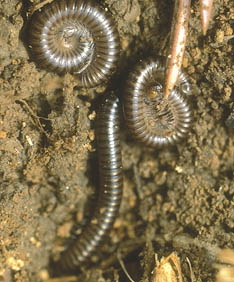 |
Figure 1: Common millipedes (Allajulus londenensis). |
Millipedes
The most common millipedes are dark brown and reach 1 to 1 1/2 inches when full grown. They are round and elongated, with many small legs. A common description is “little black worms crawling in the basement windows.” When dead or disturbed, they tend to curl into a tight coil.
Millipedes do not bite or pose any danger to humans. They feed on rotting organic matter such as leaves and wood and rarely feed on tender green leaves and roots. They spend almost all their time in moist areas, such as under rocks or logs and in lawn thatch.
Movement into houses often is sudden and sporadic. Most millipede movement takes place in September and October and again in midspring. Invasions, usually into cellars, often take place shortly after a period of wet weather and end as suddenly as they start.
Because millipedes require high moisture, they usually die in a home within a day or two. Chronic problems are associated with damp conditions. Measures taken to dry out moist areas usually are sufficient. The hard body of the millipede, however, remains intact for a considerable time after it is dead.
Because millipedes cause no damage in homes other than a minor annoyance, the best way to handle infestations is to wait a few days for the problem to subside, then vacuum the bodies that remain. Remove debris and other favorable habitats from around building foundations to help reduce problems. Seal or caulk openings around the foundation to reduce future millipede problems.
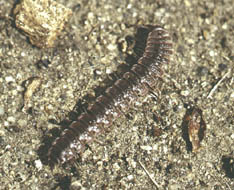 |
Figure 2: A common species of millipede found in gardens |
Where problems are persistent and severe, insecticides may help reduce invasions. These may be applied around the base of the building foundation out into lawn areas. Pyrethroid insecticides (e.g., bifenthrin, cyfluthrin, lambda-cyhalothrin, permethrin) are recommended for this use. Insecticides with these active ingredients are widely available at nurseries, sold under various trade names.
Usually only shaded sides of the home need treatment. Whole yard treatments are unnecessary and not recommended. However, most sod webworm and white grub treatments applied to lawns will also control millipedes.
When millipedes damage garden plants several practices can limit injury. Ripening fruit should be lifted off the soil, on mulch or other surfaces. Fruit that is overly ripe may be left in the garden to divert and concentrate feeding by millipedes. Similarly, millipedes can be concentrated under fruit rinds or moistened newspapers. The millipedes that are found at these sites can then be collected. Garden baits that contain carbaryl (Sevin) may also be used to control millipedes in gardens.
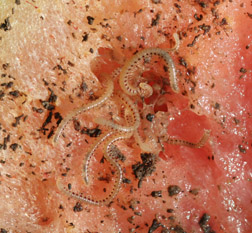 |
 |
|
| Figure 3: Young millipedes in strawberry fruit. (Photo by W. Cranshaw.) | Figure 4: Millipedes curl in defense and when dead. (Photo by W. Cranshaw.) |
 |
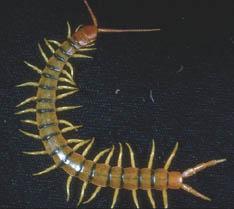 |
| Figure 5: Duff millipede. | Figure 6: Giant desert centipede |
Duff Millipede
The duff millipede is an unusual species found in some foothills areas. It reaches only 1/8 inch. It is covered with fine bristles and has a tuft of hairs protruding from the hind end. Superficially, it resembles tiny carpet beetle larvae. Close inspection shows it has far more legs than do carpet beetles.
Invasions can involve hundreds of individuals, which crawl over walls, floors and counters. Often they are concentrated near areas of high moisture, such as bathrooms, around kitchen sinks, and near outdoor hot tubs and faucets.
Although sometimes a significant nuisance, they do not reproduce or survive long in a home. Instead, they develop outdoors on decaying plant matter, fungi and algae. Prevent invasions by sealing the structure.
No effective insecticides have been identified to reduce invasions of duff millipedes. It is suggested to keep the area around foundations clean of cover and sources of moisture.
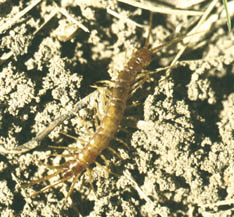 |
Figure 7: Stone centipede. (Photo by W. Cranshaw.) |
Centipedes
In general appearance, centipedes superficially resemble millipedes. However, there are important differences. Centipedes have one pair of legs per body segment; millipedes appear to have two pairs on most segments. A centipede’s legs are usually quite prominent. Centipedes are far more active than millipedes, particularly the common house centipede. Most are flattened and elongated. They feed on small Insects and other arthropods.
Centipedes usually are less common in homes than millipedes. However, they may be far more conspicuous, particularly the giant desert centipede that can reach 6 inches in length.
In homes, centipedes are found most frequently in the morning trapped in bathtubs or wash basins. They also may be seen darting for cover when a light is turned on in a dark room. Occasionally, a startled centipede may run at the person entering the room, giving the incorrect impression that it is attacking.
Except for the largest species, centipedes cannot bite through skin, so hazard to humans is remote. Bites are extremely rare, because centipedes are light shy and bite only when being picked up or crushed. The bite of the largest species is reported to cause a sharp, temporary pain, similar to a bee sting.
Control is similar to that for millipedes — wait out the problem and control moisture sources in and around the home. Infestations usually involve only a few individuals. Extreme situations in homes may require insecticides as indicated for millipedes. Interior applications of insecticides are not recommended.
Sowbugs and Pillbugs
Sowbugs and pillbugs (roly-polys) are small, gray crustaceans usually found outdoors under rocks or other cover. They feed on decaying vegetable matter and occasionally small plants. They do not bite and are harmless to humans.
During some times of the year, particularly after extended wet spring weather, sowbugs and pillbugs may move into homes. Their survival is often shorter than for millipedes and centipedes. Because of this and the minor annoyance they cause, control generally is unnecessary. Controls effective for millipedes and centipedes also are effective for sowbugs and pillbugs.
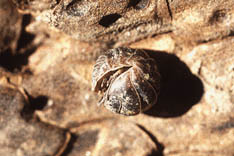 |
 |
|
| Figure 8: Pillbug, also knows as ‘Roly-Poly’. | Figure 9: A pillbug (rolled-up) and sowbug. (Photo by Whitney Cranshaw.) |
* Colorado State University Extension entomologist and professor, bioagricultural sciences and pest management. 1/00. Revised 12/13.
Colorado State University, U.S. Department of Agriculture and Colorado Counties cooperating. Extension programs are available to all without discrimination. No endorsement of products mentioned is intended nor is criticism implied of products not mentioned.
Go to top of this page.





